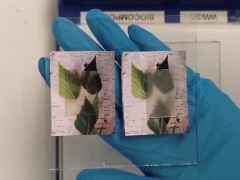Features
Hot wood
Date: 2019-04-15 10:53:08.0
Author: Jon Evans

The transparent wood developed by scientists
at KTH Royal Institute of Technology becomes
cloudier (right) upon the release of stored heat.
Photo: American Chemical Society.
Usually, when wood is heated it simply bursts into flames. But several research groups have recently shown that by chemically modifying wood they can get it to do various other useful things when heated, including generate electricity, act as a sensor and store the heat for later use.
Over the past few years, scientists have discovered several promising thermoelectric materials, which are able to generate electricity from a temperature difference. This raises the intriguing possibility of generating electricity from low-grade heat sources, including waste heat from engines, solar heat and even body heat – as long as the thermoelectric materials can be made efficient enough.
Now, a team of scientists from the US and Canada, led by Liangbing Hu at the University of Maryland, has found a way to turn wood into a particularly efficient thermoelectric material. Using basswood as the base material, they first treated it to extract the lignin and dissolve the hemicellulose, leaving behind a membrane made up of aligned cellulose nanofibers. They then chemically modified the surface of the nanofibers to make them negatively charged and impregnated the network with a sodium hydroxide-based polymer electrolyte.
Because the surface of the nanofibers are now negatively charged, they attract the positively-charged sodium ions in the electrolyte but repel the negatively-charged hydroxide ions. This means that heating one end of the membrane induces a flow of ions that can be used to generate electricity. As the scientists report in a paper in Nature Materials, this cellulose membrane can generate 24mV for every 1K difference in temperature, which is better than many other thermoelectric materials.
Another application of thermoelectric materials, for which their efficiency doesn’t need to be as high, is as a temperature sensor. But it turns out that wood can do better than that, because a team of Swedish scientists, led by Xavier Crispin at Linköping University, has developed a novel wood-based aerogel that can simultaneously act as a temperature, humidity and pressure sensor.
To produce this aerogel, Crispin and his team again utilized cellulose nanofibers from wood. They mixed these nanofibers with a solution of a conducting polymer called PEDOT:PSS, which has the useful ability of being able to conduct both electrons and ions. They then freeze-dried this mixture in a vacuum to remove the water, turning it into an aerogel. Finally, they treated the aerogel with polysilane in order to enhance its elasticity.
As the scientists report in a paper in Advanced Science, this aerogel was thermoelectric, allowing it to act as a temperature sensor. But as it also conducted ions, it could act as a humidity sensor, because humidity affects how fast ions travel through the aerogel. And as it was elastic, it could also detect pressure, because its resistance to electric current falls as it is squashed. Furthermore, because each of these effects produces a different type of electric signal, the aerogel can measure temperature, pressure and humidity at the same time, which could proveof use for medical diagnostics, wearable devices and robotics.
Rather than use wood to turn heat into electricity, Lars Berglund and his colleagues at KTH Royal Institute of Technology in Stockholm, Sweden, wanted to use it to capture and release heat on demand. In particular, they wanted to find a way to get their transparent wood to capture and release heat.
Berglund and his colleagues had initially developed this transparent wood in 2016 by removing the lignin from balsa wood, as lignin is mainly responsible for blocking the passage of light. That wasn’t sufficient, though, and so they also impregnated the delignified wood with acrylic, also known as Plexiglass. This produced a hazy, transparent material that Berglund and his colleagues thought could be used as a construction material for letting in more light.
Next, they turned their attention to heat, because ideally this transparent wood would trap heat during the day to keep interiors cool and then release it at night to keep them warm. As Berglund and his colleagues reported at a recent national meeting of the US American Chemical Society, they achieved this by adding polyethylene glycol (PEG) to the delignified wood. This polymer melts at around 25°C, trapping heat during the day, and then solidifies as the temperature falls at night, releasing the heat into the room, all without having to set fire to any wood.
The views represented here are solely those of the author and do not necessarily represent those of John Wiley and Sons, Ltd. or of the SCI.
Displaying 2 keywords used to tag this article:
- Jules Audemars-Australia Best Quali
- DG6582 Mens Moncler Down Jackets Gr
